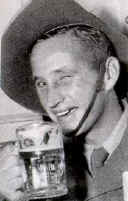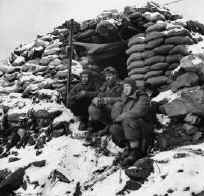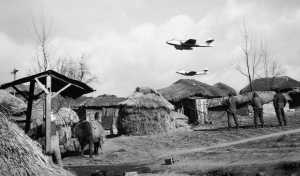The story of Mo Gwyther, POW

When the Korean war started Mo was 23 years of age and one of the first to enlist. Mo was too young to take part in the Second World War but he was eager to do his bit in the Korean War. Mo's family had a proud military background: his father Captain L. T. Gwyther, was awarded the MC (Military Cross) and Bar for bravery during the Second World War.
He saw action almost immediately upon arriving in Korea in September 1950. During October he was wounded in the shoulder. After a full recovery he returned to combat duties. During the Chinese offensive of April 1951, Mo's Company, positioned at Kapyong, came under heavy fire and he was one of three Australians captured by the Chinese.
Mo takes up the story of his time as a POW:
‘I saw four planes coming in at eye level towards our slope, their big napalm containers beginning to fall ... I wasn't burnt but I was concussed by the bombing and was unconscious. When I came to I was surrounded by Chinese.
Bob Parker and Don Buck had spent six months in Camp Twelve, an Indoctrination School. Their schools took in many UN prisoners and attempted to convert them to communism ... Not one Australian fell for this stuff ... We were the first Australians in any war to stand up to brain washing.’
Like Bob Parker and Don Buck, Mo attempted to escape but he was eventually caught and severely punished.
‘(They) put us in a little cell with us all crowded in, called the Sweat Box. We had to stand, or sit with our legs out stretched, at attention, not speak, no sound, from 4.30 in the morning until 11.00 pm. Sometimes, Tang, the Provost-Marshall, and his larrikins beat us with their rifle butts ... until we were unconscious. We were starved, could only to the lavatory once a day, even then the guards decided the time and that was bad because we all had dysentery ... upon release from the box we were ordered to write a confession, ‘a self-criticism’ for attempting to escape. If it wasn't good enough it was back in the Sweat Box ... Now we knew it was just a matter of keeping cool, never get hot under the collar, never give them an excuse to shoot you or beat you up too badly and things would work out.’
(Based on Patsy Adam-Smith, Prisoners of War from Gallipoli to Korea, Viking, Melbourne 1992, p 574-578)
Of the twenty-nine Australian soldiers taken prisoner, only one, Madden, posthumously awarded the George Cross, died. The rest were repatriated home. Those of No 77 Squadron RAAF who were posted missing, 31 in all, were not so lucky. Only seven were repatriated. Their treatment was as violent as that handed out to prisoners of the Japanese in World War Two.
46° below freezing
A.A.P. - Reuter Thurs. - The noise of bursting bottles of frozen beer has awakened Australian troops in their humpies in Korea.
The temperature in the Australians' frontline area in the last few days has dropped to 46° below freezing point. Soldiers could not crack the shells of frozen eggs with rifle butts. Men had to remove inch-long icicles from their moustaches before they could eat. (Daily Telegraph, 19 January 1951)
Huchies

At the front the troops lived in ‘huchies’ (pronounced ‘hootches’), the Korean War equivalent to the ‘dug-outs’ and ‘foxholes’ of previous wars. At their best these shelters were warm and deep and comfortable, buttressed with stout Oregon rafters, built up with sandbags, furnished with camp stretchers and oil or wood stoves. At their worst they were miserable holes in the ground, where a man couldn't stand and was often forced to sleep in his full battle kit.
(N. Bartlett, With the Australians in Korea, reprinted in G. Spenceley and H. Simmelhaig, For Australia's Sake, Nelson, Melbourne 1984, p142
Food
‘Probably enough food was supplied’, said Private Norman Taugge, ‘but it was always too far behind the front line. American troops are better fed, clothed, and looked after than the Australians,’ he added. ‘I was in boots for eight days and nights and was not allowed to wash.’
‘We were marched across the mountains near the 38th Parallel on only one meal and on one bottle of water.’ (Sydney Morning Herald, 24 November, 1950)
Camouflage
... And the enemy were, and remain, wizards at camouflage. Their drab-coloured troops merged into a drab-coloured background, move rapidly by night over by-paths and mountain tracks.
(N. Bartlett, With the Australians in Korea, reprinted in G. Spenceley and H. Simmelhaig, For Australia's Sake, Nelson, Melbourne 1984, p138)
Saboteurs
North Korean and Chinese saboteurs, spies and guerrillas mingled in disguise with the flowing hordes. Sometimes young communist soldiers marched among the refugees, hiding automatic weapons and grenades under the loose white clothes that covered their uniforms.
(N. Bartlett, With the Australians in Korea, reprinted in G. Spenceley and H. Simmelhaig, For Australia's Sake, Nelson, Melbourne 1984, p138)
RAAF attack

Here the American and Australians went hurtling down, spewing rockets and jellied petrol, the deadly napalm. A knuckle of heat - 1,000°C within a few seconds of impact - spread out across the land and turned tanks into welded ovens and left dead men bloated with heat and crusted burns.
(Adapted from N. Bartlett With the Australians in Korea. Australian War Memorial, Canberra, 1954, pp 14-15)
Naval rescue
The destroyers HMAS Warramunga and HMAS Bataan took part in one of the most dangerous naval operations of the War. They sailed through heavy seas and snow storms in to the Taedong River to rescue wounded UN troops and Korean refugees from the town of Pyongyang that was under siege by Chinese forces in December 1950. The ships avoided mine fields and destroyed enemy positions during the successful 7 hour action.
(N. Bartlett, With the Australians in Korea, reprinted in G. Spenceley and H. Simmelhaig, For Australia's Sake, Nelson, Melbourne 1984, p141)
Night patrols
At night, patrols slipped out through the wire and mine fields to test the position of opposition defences, to try to capture prisoners or to otherwise harass the enemy. Artillery and mortar duels were a regular feature of frontline life, and caused many causalities.
(Adapted from N. Bartlett With the Australians in Korea. Australian War Memorial, Canberra, 1954, pp 14-15)
Pat Owen on Death Valley
We were on the 38th Parallel near what we called the Valley of Death. Nobody could bury their dead. The Valley separated us and the Chinese. If you were killed in a valley they had to leave your body there. Even at night they put flares up and you would get caught. There were thousands of bodies, all decomposing. The winter preserved them but in the summer, when the bodies were swollen and the wind was blowing our way, they were on the nose.
(Alick Jackomos and Derek Fowell, Forgotten Heroes: Aborigines at War from the Somme to Vietnam, Victoria Press, Melbourne, 1993, p73)
Living conditions
The terrain and climate made conditions in Korea difficult for Australian troops there. Almost 80 per cent of Korea is mountainous: the effort of moving even short distances over mountains and valleys was exhausting and time-consuming.
Soldiers also had to cope with extremes of temperature, with heat as well as cold. The pervading, numbing cold of the winters is well remembered by veterans. Soldiers slept with their guns to their chests, to keep the parts from freezing up. Living and fighting in this climate posed a constant struggle, creating difficulties with transport, the movement and maintenance of supplies and the soldiers' health. The Americans and British eventually issued Australian soldiers with improved protective clothing.
The heat of the Korean summers also presented problems. Flies, mites and mosquitoes and the difficulties of finding clean drinking water often plagued the troops.
(Extract from Out in the Cold, The Australian War Memorial's online exhibition on Korea)





